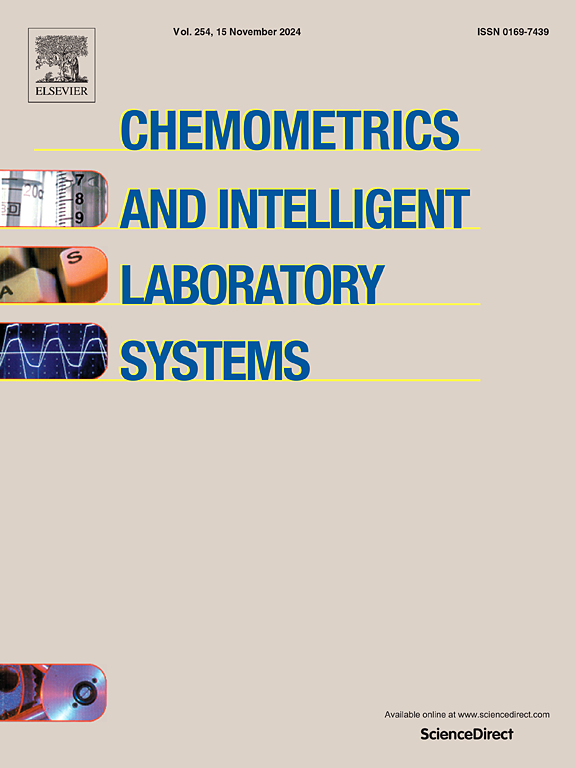所有稀疏PCA模型都是错误的,但有些是有用的。第三部分:模型解释
IF 3.8
2区 化学
Q2 AUTOMATION & CONTROL SYSTEMS
Chemometrics and Intelligent Laboratory Systems
Pub Date : 2025-08-12
DOI:10.1016/j.chemolab.2025.105498
引用次数: 0
摘要
稀疏主成分分析(sPCA)是一种流行的矩阵分解方法,它结合了方差最大化和稀疏性,最终目的是提高数据解释。在这一系列的论文中,我们表明,即使面对简单的数据,sPCA的因式分解也可能是复杂的。在本系列的第一篇文章中,我们证明了当负载重叠时,sPCA模型在准确分解稀疏和无噪声数据方面存在局限性。在第二篇论文中,我们证明了基于通货紧缩的sPCA算法可以在高阶分量中产生伪影。我们还表明,分数正交化和标准正交载荷的结合是避免大型伪影的合适方法。这两种方法都以一种非常相似但难以理解的方式约束了可能的sPCA解决方案集。特别地,我们在本文中研究了邹等人的sPCA解决方案,根据我们的结果,它代表了该系列中考虑的最佳sPCA算法。在这里,我们提供了新的模型方程的推导,模型参数的计算和解释以及在实际情况下元参数的选择,使sPCA成为一个更强大的数据建模工具。本文章由计算机程序翻译,如有差异,请以英文原文为准。
All sparse PCA models are wrong, but some are useful. Part III: Model interpretation
Sparse Principal Component Analysis (sPCA) is a popular matrix factorization that combines variance maximization and sparsity with the ultimate goal of improving data interpretation. In this series of papers we show that the factorization with sPCA can be complex to interpret even when confronted with simple data. In the first paper in this series, we demonstrated that sPCA models have limitations with respect to factorizing sparse and noise-free data accurately when loadings are overlapping. In the second paper, we showed that sPCA algorithms based on deflation can generate artifacts in high order components. We also show that scores orthogonalization and the incorporation of orthonormal loadings are suitable means to avoid large artifacts. Both approaches constrain the set of possible sPCA solutions in a very similar but poorly understood way. In particular, we study in this paper the sPCA solution by Zou et al., which according to our results represent the best sPCA algorithm of those considered in the series. Here, we provide new derivations on the model equations, the computation and interpretation of the model parameters and the selection of metaparemeters in practical cases, making sPCA an even more powerful data modeling tool.
求助全文
通过发布文献求助,成功后即可免费获取论文全文。
去求助
来源期刊
CiteScore
7.50
自引率
7.70%
发文量
169
审稿时长
3.4 months
期刊介绍:
Chemometrics and Intelligent Laboratory Systems publishes original research papers, short communications, reviews, tutorials and Original Software Publications reporting on development of novel statistical, mathematical, or computer techniques in Chemistry and related disciplines.
Chemometrics is the chemical discipline that uses mathematical and statistical methods to design or select optimal procedures and experiments, and to provide maximum chemical information by analysing chemical data.
The journal deals with the following topics:
1) Development of new statistical, mathematical and chemometrical methods for Chemistry and related fields (Environmental Chemistry, Biochemistry, Toxicology, System Biology, -Omics, etc.)
2) Novel applications of chemometrics to all branches of Chemistry and related fields (typical domains of interest are: process data analysis, experimental design, data mining, signal processing, supervised modelling, decision making, robust statistics, mixture analysis, multivariate calibration etc.) Routine applications of established chemometrical techniques will not be considered.
3) Development of new software that provides novel tools or truly advances the use of chemometrical methods.
4) Well characterized data sets to test performance for the new methods and software.
The journal complies with International Committee of Medical Journal Editors'' Uniform requirements for manuscripts.

 求助内容:
求助内容: 应助结果提醒方式:
应助结果提醒方式:


